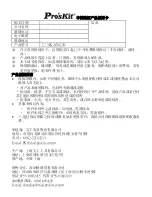
OPERATING INSTRUCTIONS
To Test Wires or Cables
(
CAUTION :
Do not connect the Tone Generator in the TONE
position to any wire or cable with an active DC circuit exceeding 48V)
1. Connecting the Tone Generator, turn the switch to the TONE position,
connect the line as follow:
a. For terminated working cables : connect Red test lead to the
terminated wire and Black test lead to the earth or equipment ground.
b. For non-terminated or non-working cables : Black test lead connect to
a non- terminated/non-working wire.
2. Set the Amplifier Probe to the SCAN or LED position.
3. Turn on the probe volume thumbwheel, press the power button.
4. Adjust the volume with the volume control. Increase the volume to
overcome noise, decrease to reduce interference.
5. Position the tip of the probe close to the insulation of each of the suspect
conductors. The volume will be loudest on the wire connected to the
tone generator.
6. In noisy or dark environments the signal LED provides and alternate
method of identification. The signal LED will display a brighter RED the
closer it is to the connected wire.
Note:
There are a tone switch inside of the Tone Generator, provide
one tone or dual tone selection. To adjust the tone, remove the
battery cover and change the switch position.
NCV (Non-Contact Voltage) Testing
:
Caution :
The feature can be used before wire or cable test, it can help to
identify if the tested cable is with AC voltage. It can not only help
to ensure the safety of user and avoid possible electric shock or
personal injury, but also protect the product from being damaged
by AC power.
1.
Turn the Amplifier Probe function switch to “NCV”, the function is started
when the power indicator is on.
2. Place the Amplifier Probe tip to the tested cable, the NCV indicator
twinkles fast and the buzzer sounds, which means the tested cable has
AC 90~1000V.
3. If there is no response of indicator and no buzzer sounds, it means the
tested cable has AC power less than 90V or there is no AC power on it.





































